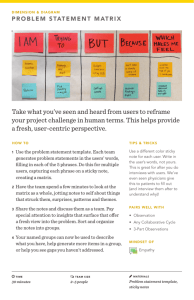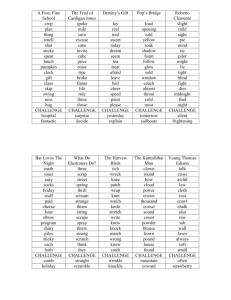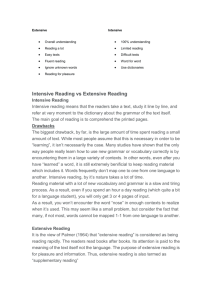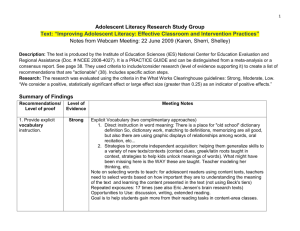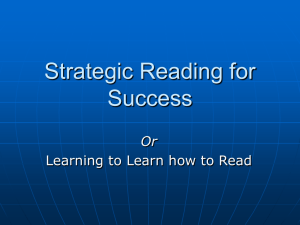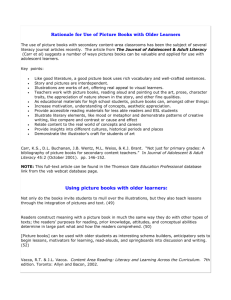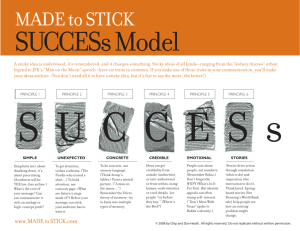Eileen Kintsch Text Talk: Thinking About Texts
advertisement
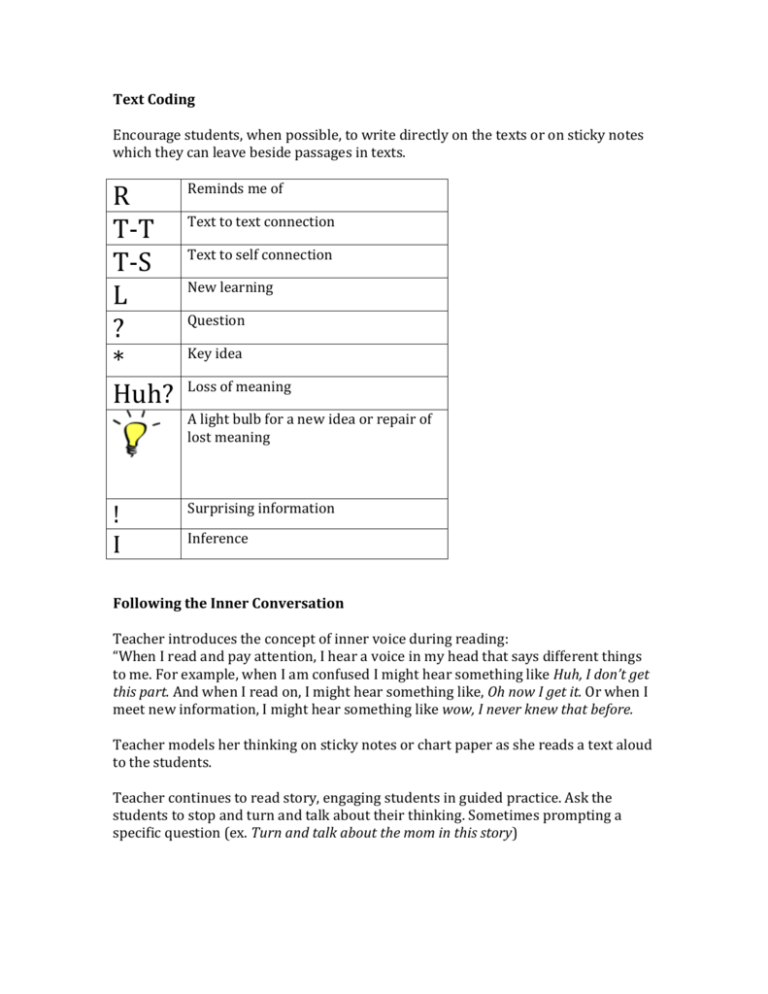
Text Coding Encourage students, when possible, to write directly on the texts or on sticky notes which they can leave beside passages in texts. R T-T T-S L ? * Huh? Reminds me of Text to text connection Text to self connection New learning Question Key idea Loss of meaning A light bulb for a new idea or repair of lost meaning ! I Surprising information Inference Following the Inner Conversation Teacher introduces the concept of inner voice during reading: “When I read and pay attention, I hear a voice in my head that says different things to me. For example, when I am confused I might hear something like Huh, I don’t get this part. And when I read on, I might hear something like, Oh now I get it. Or when I meet new information, I might hear something like wow, I never knew that before. Teacher models her thinking on sticky notes or chart paper as she reads a text aloud to the students. Teacher continues to read story, engaging students in guided practice. Ask the students to stop and turn and talk about their thinking. Sometimes prompting a specific question (ex. Turn and talk about the mom in this story) Students can write their own sticky notes as teacher reads another story. They share their notes in a group and talk about what they learned in the story and what they noticed within their own thinking. When Meaning Breaks Down Create a two-column chart. Brainstorm in the class to complete the chart. When Meaning Breaks Down Tired Don’t like the book Too hard What to Do About It Reread to construct meaning Choose another book Think about what you know and try to connect it to new information Can you choose another book? Etc. Noticing and Exploring Thinking Give students a large sticky note Teacher reads a text to students. Encourage students to record what the story makes them think about (i.e. connections) not a retelling On a large chart paper titled (Title of Story makes us think about…) collect the sticky notes. Discuss the different thinking within the class Beginning to Make Connections: It Reminds Me of…. The character is like me… The story is like my life… This text is like this other text…. Students code ‘R’, ‘T-S’, ‘T-T’ and write a few words on their sticky notes of what connection text reminded them of Record the student responses in two column form: What the Story is About What it Reminds Me Of Noticing and Thinking About New Learning Teacher models, guided practice, and then students code ‘L’ and a comment about their learning on a sticky note Rethinking Misconceptions: New Information Changes Thinking Teacher models, guided practice completing chart before and after reading a text. Students code ‘L’ and their comments as they listen/read the text. Record a variety of responses in the “What We Think We Know” and “New Learning” columns. The Circulatory System Before Before Questions Why does my heart beat? What We Think We Know Your heart beats. If your heart isn’t beating you are dead. Why do I shiver when I get You shiver because your cold? blood is cold. After New Learning Your heart helps you with your blood. It moves blood all around your body. Because you are trying to keep yourself warm, this is why we shiver. I learned when you shiver you warm up. Now I know when you get the shivers you get warm for a little bit. The More We Learn, the More We Wonder Students pose a research question. They record and share the answer they find on the response sheet. Teacher records an “ I Learned/ I Wonder” chart I Learned Leopard seals eat penguins I Wonder Do they eat the feet? Some Questions are Answered, Others Are Not Chart students’ questions, after their research code the questions as answered or unanswered. If answered, code the source of the answer A BK RS I Huh? D Answered Background Knowledge Researched Inferred Unanswered For discussion Questions and Facts Students prepare a two-column Questions/Fact chart prior to reading. They record both answers to their questions and additional facts they find during the reading. Thick and Thin Questions Use sticky notes and sticky flags to show students the differences between thick and thin questions. Thick questions generally start with “Why” or “How” Thin questions are usually factual “What, when, where” Question Webs Students form research teams. They look through different texts to answer a common question. Post their response(s) on the chart forming a web. Visualizing in Nonfiction Text: Making Comparisons Point out when texts use comparisons to help the reader more meaningfully make comparisons. Creating Mental Images that Go Beyond Visualizing After reading or listening to a piece of text, students complete a response with the following frame… I see… I hear… I can feel… I can smell…. I can taste… Inferring the Meaning of Unfamiliar Words Complete a four-column think sheet Word Inferred Meaning Clues Sentence Manicurist Someone who trims nails The name of something Railroad worker who carries bags and helps passengers Reading on A manicurist trims nails. The Defender was a Chicago newspaper. The Pullman porter helped the woman off the train. The Defender Pullman porter Capital letters Picture Inferring with Text Clues Complete a three-column chart Background Knowledge Text Clues Inference Moms can get cranky when they are rushing to work in the morning. Babysitters should be watching kids. She says no when he asks for a dog. He has probably asked for a dog over and over. She is watching TV and the dad looks mad in the picture. The dad is mad because she is not doing her job. Building Knowledge of Nonfiction Features Teach students to identify and know the purposes of comparisons, captions, and labels in non-fiction texts. Coding Important Information on Unfamiliar as Well as Familiar Topics Provide sticky notes. Model or let students code as they read. ‘L’ for information they learned while reading the text. ‘*’ for important information. Finding Important Information Rather than Just One Main Idea Give each student 3 sticky notes, coded with ‘*’ for important information. Ask the students to place the notes at 3 points of important information. Ask the class to share what they thought was important – they will vary, but this is the point. Ask the students to justify why they thought a particular piece of information was important. Sifting the Topic from the Details Give each student a 3 section chart as they begin to read a non-fiction piece. Point out that the headings are often the topics. Students organize the details under topics as they read, then write a response about the text. Topic Dog family Packs Details All dogs are descended from wolves Wolves are canines Feed mainly on large animals Pet dogs do not survive in the wild 4-7 in a pack sometimes 15 or so in a pack alpha – big daddy leader alpha female – leader’s wife sometimes kill if others intrude Response Paraphrasing to Summarize Expository Text Draw square brackets around a section of text, write a summary sentence in the margin or alternatively, put a sticky note with the summary on the section. Writing a Short Summary Complete a two-column chart that distinguishes between summarizing and personal response. What the piece is about…. What it makes me think about…. Synthesizing to Access Content Complete a two-column chart as you read. Record facts and your thinking (coded). Content (Facts) Process (Thinking) Also can record a three-column chart that comments on the author’s craft. Content (Facts) Process (Thinking) Craft (Writing) Hallmarks for Creating an Environment for Thoughtful Content Literacy Instruction The learning opportunities we create Focus on comprehension and understanding rather than memorization Connect us with real-world, real-life issues Center around content-related big ideas, essential questions, and key concepts Engage students’ interest and enthusiasm Encourage student choice and independent thinking Provide time for thinking to take place Set expectations that push students towards higher levels of thinking When we demonstrate our thinking, we Illustrate what good thinking looks like Focus on topics and ideas worth thinking about Reveal our curiosity, interests, and passions Explicitly show how we understand what we read through questioning, drawing inferences synthesizing information and so forth We support attitudes and interactions that Emphasize a common language for talking about thinking and learning Encourage and respect different viewpoints and perspectives Ensure that students experience positive ways of thinking about and engaging with content Spark thoughtful discussion and debate Support students’ enthusiasm for discovery and their readiness to investigate what’s new or unusual Student artifacts and work products Are the result of thoughtful work and send the message that thinking matters Make thinking visible Involve sharing knowledge and teaching others Illustrate the process of thinking and learning Materials/texts/literature that students read Encourage a variety of perspectives, opinions, and interpretations Require students to solve or discover problems Provoke discussion and raise significant issues Focus on content-related themes, issues, and/or essential questions Good reading on the Web www.nationalgeographic.com/kids www.timeforkids.com/TFK www.nwf.org/kids (National Wildlife Foundation) www.nytimes/learning (New York Times kids’ edition) www.howstuffworks.com www.whyfiles.org (click on The Why Files in Education link) www.ocean.com www.ecokidsonline.com (Earth Day Canada’s site) www.exploratorium.org www.siforkids.com (Sports Illustrated for kids) www.kidsdiscover.com www.si.edu (press kids button – Smithsonian Institute’s website) http://edspace.nasa.gov www.pbs.org/teachersource Examples of Inference Questions Integrating or using one’s own world knowledge combined with text information, or by linking pieces of information from different parts of the text Describe some other examples of how gravity works. Explaining concepts, processes, causes, antecedents, or results not explicit in the text, such as a conclusion, or a character’s motivation or emotional state in a story Explain why gears, pedals, wheels, and axles are all machines. Describe how the boys felt at the end of the story. Why did they feel this way? Predicting information that will come later in the text How do think roller coaster cars can go up steep hills? Speculating about what if? what if not? What would happen if the roller coaster climbs a couple of short hills before climbing the steepest hill? Eileen Kintsch Text Talk: Thinking About Texts Within the Text Recount important events from the text. Describe characters, setting, or events. Report or list new ideas or information gained from reading. Summarize the story or ideas. Provide specific evidence from personal experience or the text to support theories or inferences. Draw the group’s attention to a specific part of the text or to illustrations that convey specific information. Beyond the Text Express hypotheses, inferences, predictions, or theories. Disagree with a statement made by another reader. Reconsider ideas. Talk about personal responses and connections. Contribute prior knowledge for the benefit of the group. Interpret illustrations. Link evidence from the text with inferences, hypotheses, predictions, or theories. Talk about the central them or meaning of the text. Seek many interpretations. About the Text Identify literary elements. Use literary terms. Attend to the language of a text. Draw the group’s attention to aspects of the writer’s craft using examples from the text. Talk about the characteristics of the genre offering examples from the text. Draw the group’s attention to literary aspects of the text (e.g. symbolism). Challenge to accuracy of an author’s statement. Offer a wellinformed criticism of some aspect of the text, using evidence to support the argument. Fountas & Pinnell Ten Suggestions for Extending the Meaning of Texts 1. Discuss the book in pairs of threesomes. 2. Diagram the internal organizational structures in texts – comparison/contrast, problem/solution, cause/effect, sequence, question/answer, story map. 3. Prepare graphic organizers (a character web or a timeline, for example) to reveal the author’s craft. 4. Comment on the text in interactive or shared writing. 5. Describe characters, summarize sections of the text, or make a list of key ideas in interactive or shared writing. 6. Respond with “quick writes” that can be shared later. 7. Respond with “quick sketches” that support thinking and can be used as a basis for more talk or writing. 8. Present a readers’ theater piece using portions of the text. 9. Write a poem about the book. 10. Collect favorite quotes from the text and tell why you chose them. PLUS… Have students write a letter to you about their thoughts on a book. Have the students write a letter to one of the characters in the story. Have students compose a letter as one of the characters in a story writing to another character or to a situation beyond the text. How Do We Really Know if Students Comprehend Deeply? -Ellin Oliver Keene Thinking patterns the characterize deeper comprehension: The Outcomes and Dimensions of Understanding Narrative Text Expository Text Readers experience empathy. Character empathy Setting empathy Conflict empathy Author empathy Readers experience a memorable emotional response. Readers experience the aesthetic. Readers ponder, pause, and consider. Readers think about the book when they’re not reading and generate new ideas and imagine new possibilities. Readers focus, advocate, and evaluate. Learners describe a fascination with ideas. Understand leadership Understand context and conditions that lead to important discoveries Understand problems that led to discoveries Learners experience a memorable emotional response. Learners experience the aesthetic. Learners revisit and rethink. Learners generate own hypotheses and theories. Learners direct their energy to comprehending a few ideas of great import. Readers recognize patterns and symbols. Learners recognize patterns and text structures including: Cause/effect Recognize comparisons and contrasts Chronology Problem/solution Readers extrapolate from details in the Learners create schema and realize how text – they arrive at global conclusions newly learned concepts “fit” into existing from focal points in text. background knowledge. Readers recognize the influence of Learners recognize the influence of beliefs/values/opinions. beliefs/values/opinions. Readers remember. Learners remember. Samatha Bennett Developing “I can statements” as reading goals, then using mini-lessons to show students how to achieve those goals: In order to… I can Analyze Skim a text to Use a text to Critique a text Develop Describe my thinking Identify evidence in the text of Name Describe Identify Define Know the difference between Represent Mathematically model Find information that relates to Be an active member of our group Complete my part of the group project on time I can push myself and my group members by asking questions and thinking deeply about a Mini-lesson skills Assessment topic
